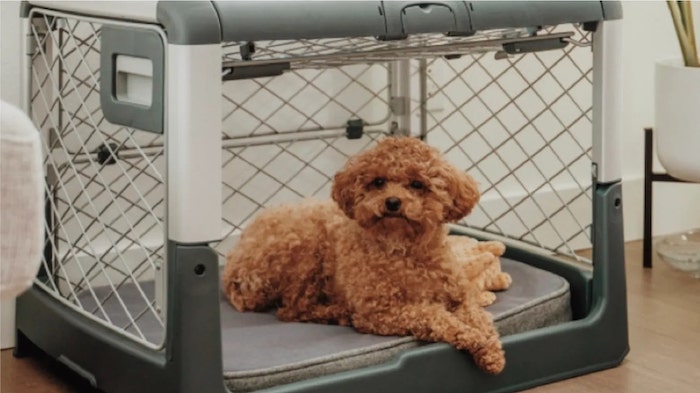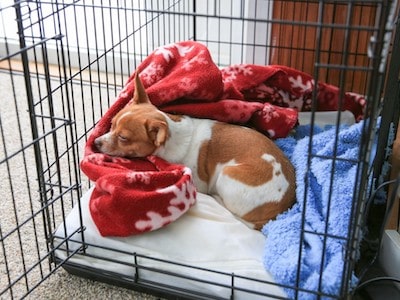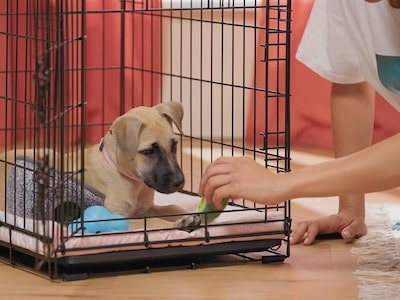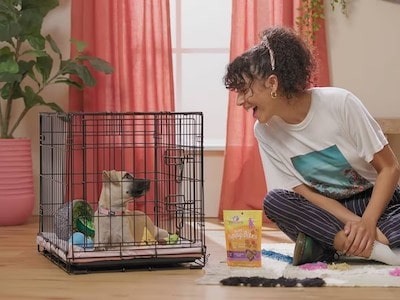Overview of crate training for dogs
Crate training is a highly effective and popular method for dog owners to provide their furry companions with a safe and secure space. It involves using a crate, which is essentially a small, enclosed area for the dog to rest, sleep, and relax.
While some people may have reservations about crate training, when done properly, it can be a beneficial tool that promotes positive behaviors and ensures the well-being of your canine friend.
Crate training offers a multitude of advantages for both dogs and their owners. Not only does it establish a safe space for the dog, but it also facilitates house training, prevents destructive behavior, and aids in travel and vet visits.

By implementing a top-notch crate training program, you can effectively teach your dog to view their crate as a comforting sanctuary rather than a confinement.
In this article, we will explore the benefits of crate training in more detail, provide tips for finding a reputable crate training program, and share essential questions to ask when choosing a trainer.
We will also offer valuable insights on how to successfully implement crate training at home. So, if you’re ready to embark on this journey of creating a harmonious environment for your beloved companion, let’s dive right in!
Benefits of Crate Training
Crate training can provide numerous benefits for both dogs and their owners. By creating a safe and comfortable space for your furry friend, you can establish a positive environment that promotes their overall well-being. Let’s explore some of the key advantages of crate training.
Establishing a Safe Space
Crate training allows dogs to have a designated safe space that they can call their own. Just like humans, dogs also need a place where they can retreat to when they feel overwhelmed or anxious. By providing them with a crate, you are giving them a cozy den-like area where they can seek solace and feel secure.
Facilitating House Training
One of the most significant benefits of crate training is its effectiveness in house training. Dogs naturally have a denning instinct, and a crate can mimic the feeling of a den for them.
When properly introduced to the crate, dogs learn to associate it with their sleeping and resting area. This association helps them develop control over their bladder and bowels, as they are less likely to soil their own space.

Preventing Destructive Behavior
Dogs, especially puppies, can exhibit destructive behavior when left unsupervised. Crate training plays a vital role in preventing destructive behavior by providing a safe confinement area for your furry companion.
When you are unable to directly supervise your dog, placing them in the crate can prevent them from chewing on furniture, shoes, or other household items that may be tempting to explore.
Aiding in Travel and Vet Visits
Crate training also proves to be invaluable when it comes to traveling with your dog or taking them to the veterinarian. A well-trained dog who is comfortable in a crate will experience less stress during car rides or visits to the vet.
The crate becomes a familiar and secure space for them, reducing anxiety and making the overall experience more pleasant for both you and your furry friend.
By understanding the benefits of crate training, you can see why it is an essential aspect of dog ownership. However, finding a top-notch crate training program is equally important. In the next section, we will explore how to find the right program for you and your dog.
But before we move on, have you considered other training programs for your dog? If not, you may also be interested in exploring options such as puppy training near me, service dog training near me, clicker training for dogs, agility training for dogs, leash training for dogs, behavior training for dogs, dog obedience classes near me, therapy dog training near me, or private dog trainers near me.
Additionally, if your dog suffers from separation anxiety, you may want to consider dog training for separation anxiety to help them cope with their distress.
Finding a Premier Crate Training Program
When it comes to crate training your beloved furry friend, finding a top-notch program is essential for their well-being and development.
Whether you’re a first-time dog owner or looking to refine your existing crate training skills, choosing the right program can make all the difference.
Here are some valuable tips to help you find the perfect crate training program for your canine companion.
Research Local Dog Trainers
Begin your quest for the ideal crate training program by researching local dog trainers in your area. Take advantage of the vast resources available online to explore the options near you. By searching for “puppy training near me” or “service dog training near me,” you can easily find a list of qualified trainers who specialize in crate training.
Read Reviews and Testimonials
Once you’ve compiled a list of potential trainers, take the time to read reviews and testimonials from other dog owners. Positive feedback from satisfied clients is a strong indicator of a trainer’s expertise and professionalism. Look for trainers who have a track record of successfully implementing crate training techniques and providing exceptional care for their canine students.

Visit the Facility
To ensure a top-notch crate training experience for your beloved pup, it’s crucial to visit the facility in person. This will give you the opportunity to assess the training environment and observe how the trainers interact with the dogs. By visiting the facility, you can gauge the cleanliness, safety measures, and overall ambiance, ensuring that your furry friend will receive the best care possible.
Talk to the Trainer
Engaging in a conversation with the trainer is an essential step in finding the right crate training program. During this discussion, you can inquire about their training methods and philosophies. It’s important to find a trainer whose approach aligns with your own values and goals. Ask questions about their experience with crate training and how they tailor their methods to suit individual dogs’ needs.
Ask for References
A reputable dog trainer should be more than willing to provide references from previous clients. By asking for references, you can gain insights into the trainer’s reputation and the effectiveness of their crate training program. Reach out to these references to inquire about their experiences and whether they would recommend the trainer for crate training.
By following these steps, you can be confident in your decision when selecting a top-notch crate training program. Remember, investing in your dog’s training and well-being is a long-term commitment that will benefit both you and your furry friend for years to come.
If you’re interested in learning more about other dog training techniques, such as clicker training for dogs, agility training for dogs, or leash training for dogs, be sure to explore our comprehensive resources. At Dog Loves Best, we’re dedicated to helping you build a strong bond with your canine companion through effective training methods.
Tips for Successful Crate Training at Home
Introduce the Crate Gradually
When embarking on crate training for your beloved furry friend, it’s essential to introduce the crate gradually. Slowly acclimating your dog to the crate will help create a positive association and reduce any anxiety they may feel.
Begin by placing the crate in a familiar and comfortable area of your home. Open the door and allow your dog to explore the crate at their own pace. You can entice them with treats or toys to make it more enticing. Avoid forcing them into the crate as it may create a negative experience.
Once your dog starts to show interest in the crate, encourage them to enter it. Reward their curiosity with praise and treats. Start by having them spend short periods of time inside the crate, gradually increasing the duration as they become more comfortable.
Make the Crate a Positive Space
To ensure successful crate training, it’s crucial to make the crate a positive and inviting space for your dog. Create a cozy environment by adding soft bedding and familiar scents inside the crate. This will help your dog feel secure and comfortable.
Place the crate in a quiet area of your home, away from distractions and excessive noise. Avoid placing it in an isolated spot where your dog may feel lonely or excluded from family activities.
Make the crate an enjoyable place for your dog by incorporating treats and toys. Provide them with interactive toys or chew toys to keep them entertained while inside the crate. Rotate the toys regularly to keep their interest and prevent boredom.

Use Treats and Positive Reinforcement
One of the most effective ways to encourage your dog to view the crate positively is through treats and positive reinforcement. Whenever your dog willingly enters the crate or stays inside, reward them with praise, treats, or both. This will reinforce the idea that the crate is a safe and enjoyable space.
Avoid using the crate as a form of punishment or confinement. Never force your dog into the crate or scold them when they are inside. This will only create negative associations and hinder the crate training process.
Stick to a Consistent Routine
Consistency is key when it comes to crate training. Establishing a consistent routine will help your dog understand expectations and adapt to the crate more quickly.
Create a schedule for your dog’s meals, bathroom breaks, and crate time. Feed your dog their meals inside the crate to associate it with positive experiences. Take them outside for bathroom breaks before and after crate time to prevent accidents.
Stick to the same timings for crate time to create a sense of predictability for your dog. Use a verbal cue, such as “crate” or “kennel,” when it’s time for them to enter the crate. This will help them understand the command and associate it with the desired behavior.
Remember, successful crate training takes time and patience. Be consistent, use positive reinforcement, and gradually increase the duration of crate time. With dedication and a well-established routine, your dog will come to view the crate as their safe and comfortable haven.
For more information on various dog training programs, including puppy training, service dog training, and leash training, you can check out Dog Loves Best. They provide valuable resources and can help you find dog obedience classes near you or private dog trainers who specialize in crate training and other training techniques.
Questions to Ask When Choosing a Crate Training Program
Understanding the trainer’s approach to crate training is vital in determining if it aligns with your training philosophy and your dog’s temperament. Different trainers may employ various methods, such as positive reinforcement, clicker training, or a combination of techniques. It is important to inquire about their preferred methodology and determine if it resonates with your training preferences.
Some trainers may focus on creating a positive association with the crate, while others might emphasize teaching your dog to view the crate as their den or safe space. By asking about the trainer’s approach, you can gain insight into their training methods and ensure they align with your desired outcomes.
The duration of a crate training program can vary depending on several factors, including the dog’s age, temperament, and previous experiences with crates. To better understand the time commitment involved, it’s essential to inquire about the typical duration of their training program.
Some trainers may offer short-term programs that focus solely on crate training, while others might integrate crate training into a more comprehensive obedience training curriculum. By asking about the program’s length, you can plan accordingly and ensure that the timeframe fits into your schedule.
Experience plays a crucial role when it comes to crate training. Inquire about the trainer’s level of expertise in this specific area to gauge their proficiency and track record. It’s beneficial to know if they have successfully trained other dogs using crates and if they have experience dealing with various behavioral challenges that may arise during the training process.
A seasoned trainer with a solid background in crate training will not only possess the necessary skills to guide your dog effectively but also provide valuable insights and strategies to address any potential hurdles. Asking about their experience can give you confidence in their abilities and increase the likelihood of a successful training program.
Remember, selecting the right crate training program can make a world of difference in your dog’s comfort, behavior, and overall well-being. By asking these key questions, you’ll be well-equipped to make an informed decision and find a program that meets both your and your dog’s needs.
Visit our website for more information on puppy training near me, service dog training near me, clicker training for dogs, agility training for dogs, leash training for dogs, behavior training for dogs, dog obedience classes near me, therapy dog training near me, private dog trainers near me, and dog training for separation anxiety.
Conclusion
In conclusion, crate training is a highly effective method for ensuring the well-being and obedience of your furry friend. By providing them with a safe and comfortable space, you can establish a positive association with their crate and help them feel secure in their surroundings. Additionally, crate training aids in house training, preventing destructive behavior, and facilitating travel and vet visits.
When searching for a top-notch crate training program, it’s essential to do your due diligence. Research local dog trainers, read reviews and testimonials, and visit the facility to get a sense of the environment. Talking to the trainer and asking for references can also give you valuable insights into their expertise and approach.
During the selection process, be sure to ask important questions such as the trainer’s approach to crate training, the typical duration of the program, and their experience in this specific area. This will help you find a trainer who aligns with your goals and has the necessary expertise to support your dog’s training needs.
To ensure successful crate training at home, introduce the crate gradually and make it a positive space by incorporating your dog’s favorite toys and blankets. Using treats and positive reinforcement will further reinforce their positive association with the crate. Finally, sticking to a consistent routine will help your dog understand expectations and feel more comfortable in their crate.
Remember, crate training is just one aspect of overall dog training. If you’re interested in exploring other training methods, such as puppy training, service dog training, clicker training, agility training, leash training, behavior training, or even dog obedience classes or therapy dog training, there are plenty of resources available.
Consider looking into private dog trainers near you who can provide specialized assistance. Additionally, if your dog suffers from separation anxiety, there are specific training techniques designed to address this issue.
By investing time and effort into crate training, you are setting your dog up for a lifetime of good behavior and a harmonious relationship. So, why wait? Start your journey towards a well-trained and contented pup today!
For more information on crate training and other dog-related topics, be sure to check out Dog Loves Best. They offer a wealth of resources to help you become the best dog parent you can be. Happy training!

Ellis is a retired veterinary technician and full-time contributor at DogLovesBest. He likes writing about pet health care tips and reviews the products that are useful for fidos on a daily basis.
Ellis also guardians a Siberian husky, Nova, and a cat named Shilly. They all live happily with his wife Ammy, and both the dogs on a seaside apartment in Queens, NY.
